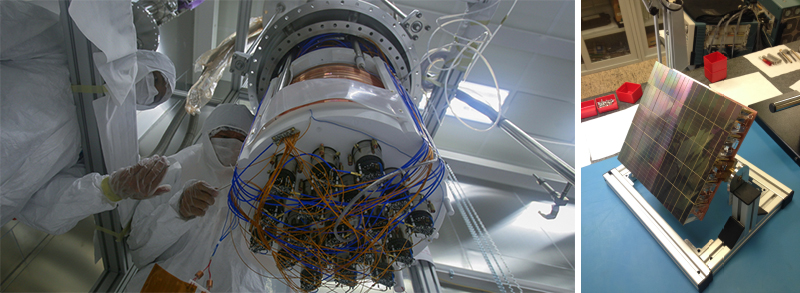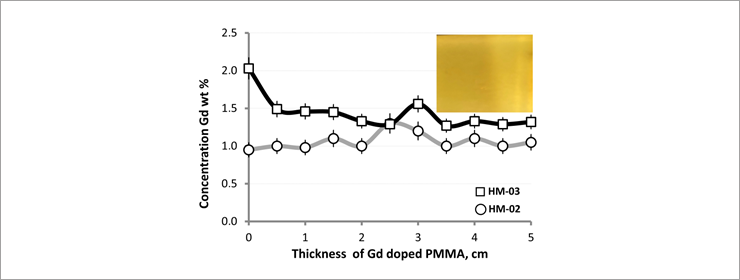Material for dark matter detectors created
News, 24 August 2021
A team of scientists with the participation of JINR developed the novel hybrid material based on plastic and the rare earth metal gadolinium. The resulting material has unique properties, which make it possible to use it for the manufacture of shells for detectors designed to detect dark matter particles. It deals with the international DarkSide-20k experiment. The results of the work were published in the journal Materials.
Maxim Gromov, a DLNP JINR junior researcher spoke about the work, “The team of scientists from the Mendeleev University of Chemical Technology (MUCT), Skobeltsyn Institute of Nuclear Physics of the Moscow State University (SINP MSU), the BSU International Scientific and Educational Radiation Physics Laboratory, and JINR has dealt with the task of the development and manufacture of a pilot batch of the ultra-low background structural material for several years. The study was performed within the international DarkSide-20k experiment, one of the largest projects on the dark matter particle search. The detector is due to start its operation in the underground low-background Gran Sasso National Laboratory in Italy in 2025−2026.
 Photo © https://www.lngs.infn.it/
Photo © https://www.lngs.infn.it/
It was necessary to develop the novel structural material for walls of inner buffer layers (veto) intended for the reduction in the neutron background level in the argon target. At the same time, the main source of background events are neutrons, which can easily imitate dark matter particle scattering off working medium nuclei. Thus, the novel hybrid material is to slow down neutrons and absorb them simultaneously emitting gamma quanta to mark background events.
The search for rare processes sets an extremely high requirement for neutron detection efficiency. The total neutron background in the sensitive target area after all data processing procedures during 10−15 years of operation should not exceed one event. This protection level can be reached only by maximal suppression of intrinsic material radioactivity arising from the presence of long-lived uranium and thorium isotopes initiating the (α,n) reactions. Thus, the requirement of the ultra-low background material is well-founded.
The external coat of the DarkSide-20k detector is a cryostat, analogous to that of the ProtoDUNE experiment. All internal materials must keep their mechanical properties at the temperature of 87 K (−186 ˚C).
 Gadolinium distribution over the thickness in samples of the novel hybrid material. A photo at top right depicts a cut of one of the samples illustrating uniformity of gadolinium distribution in polymethylmethacrylate
Gadolinium distribution over the thickness in samples of the novel hybrid material. A photo at top right depicts a cut of one of the samples illustrating uniformity of gadolinium distribution in polymethylmethacrylate
To meet all the above-mentioned requirements, the hybrid material on the basis of polymethylmethacrylate (better known as acrylic resin) should be developed with addition (better evenly across the volume) of some gadolinium compound. Computations showed that a lot of pure gadolinium should be added, approximately 1-2% by mass. The detector configuration involves a plastic structure with gadolinium with a total mass of 12 t, which should be made up of 1 x 1 x o.o5 m plates. That means that the team of scientists faced the challenge not just to elaborate a material with definite properties but to create a technology that could be scaled to the industrial production level. Since the material was not intended to be used as a scintillator, it was not required to be transparent, which facilitated the work. Physically, it was only necessary to have neutrons captured by nuclei which resulted in gamma quanta easily detected in buffer argon layers.
The objective was successfully achieved. Ultra-pure gadolinium acetylacetonate and methylmethacrylate were obtained and then successfully mixed, with this true solution being thermally polymerized. Note that the unprecedented levels of purity in uranium and thorium, 0.011 ppb and 0.016 ppb respectively, were achieved and guaranteed by the technology. The above-mentioned values are precision limits of the mass spectrometry method used.
In conclusion, noteworthy are the ideas and research management of our colleagues Igor Khristoforovich Avetissov (MUCT) and Alexander Sergeevich Chepurnov (SINP of MSU).”
 Maxim Gromov. Photo by Irina Sidorova
Maxim Gromov. Photo by Irina Sidorova
To date, experimental samples passed all the necessary tests. The infrastructure for manufacturing this novel structural material on the industrial scale is being created. As M. B. Gromov noted the material has the potential for being applied not only for basic research but also for different nuclear facilities of general purposes and devices intended for the operation in extreme weather conditions, e.g. in winter or within the Arctic Circle.
About DarkSide
There are many candidate particles for the role of dark matter, but the most common are so-called Weakly Interacting Massive Particles (WIMPs). These elementary particles are missing in the Standard Model of Physics, but they are predicted by a number of theoretical models beyond its limits.
The DarkSide project is an extensive programme for direct search for dark matter particles – WIMPs, – which is focused on a series of experiments based on liquid argon. The Dual-phase noble liquid time projection chamber is used in the DarkSide project.
Today, DarkSide is a large scientific collaboration consisting of 45 scientific centres from different countries.